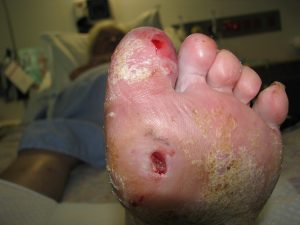 Vitamin C could be an inexpensive strategy to improve outcomes and perhaps prevent amputations in people with chronic foot ulcers, Australian research suggests.
Vitamin C could be an inexpensive strategy to improve outcomes and perhaps prevent amputations in people with chronic foot ulcers, Australian research suggests.
A study from the High-Risk Foot Clinic at Westmead Hospital randomised 16 new patients with a foot ulcer to either daily vitamin C (500 mg in a slow-release capsule) or an inactive comparator of glucosamine sulfate (1000mg in identical-appearing capsules) in addition to usual care.
When baseline serum vitamin C levels were available about 28 days later, half of the study population were found to be vitamin C deficient. Patients who were deficient were then dispensed both vitamin C and glucosamine for the next 28 days.
About half of the patients had diabetes and a similar proportion had vascular disease.
The study, published in the British Journal of Nutrition, found a 100% reduction in initial ulcer volume in patients in the vitamin C group compared to -14% in the glucosamine control group at eight weeks (p=0.041).
Median time to 50% ulcer healing was also significantly faster in the vitamin C group at a median of 20 days versus 48 days in the five of nine controls who achieved 50% ulcer healing (p=0.028).
All seven vitamin C subjects and five of nine subjects in the glucosamine group went on to complete ulcer healing at a median of 77 days.
“In this study, vitamin C treatment improved ulcer healing in the high-risk foot clinic subjects,” the study authors said.
The researchers, led by Professor Jenny Gunton, noted that 2011 Australian guidelines for the treatment of diabetes-related foot complications were overdue for review.
More recent 2019 International Working Group on the Diabetic Foot (IWGDF) guidelines recommend against nutritional interventions over standard care.
“We recommend consideration of vitamin C supplementation, preferably with a slow-release form, in all people attending for chronic foot ulcers who do not have exemplary dietary fruit and vegetable intake,” the Westmead researchers said.
They said there were about 8,000 mostly non-traumatic lower limb amputations per year in Australia and about 115,000 per year in the US in people with diabetes.
“If supplementation prevents only one amputation per 10 patients with chronic foot ulcers who would otherwise eventually undergo amputation, treating all patients might prevent more than 10,000 amputations per year in the USA alone.”
“In addition, as time to 50% ulcer healing was significantly shorter in people receiving vitamin C, it is likely that costs of running the service and costs to patients would be lower in people treated with vitamin C.”
“Ideally, given its very cheap cost to health services, and high likelihood of favourable cost outcomes, this would be provided free to patients, to improve compliance,” they concluded.
Professor Gunton, director of the Centre for Diabetes, Obesity and Endocrinology at the Westmead Institute for Medical Research, told the limbic the preliminary data should support applications for funding of a larger study.
“Regardless of the puny size of it, we had a 50% rate of vitamin C deficiency at baseline. And that is consistent with a group in Melbourne who have a 59% rate of vitamin C deficiency in their group at baseline so it’s probably extremely common.”
“And you probably can’t heal a wound without vitamin C because you can’t make collagen and you can’t fight infection.”
She said a larger study would help determine if vitamin C was equally effective in subgroups like people with diabetes and people with vascular disease, and if there was a vitamin C cut-off level to guide supplementation.